Original author: CryptoVizArt, UkuriaOC, Glassnode
Original translation: Deng Tong, Golden Finance
Summary
Bitcoin has recorded its biggest drop of the current cycle, trading more than 26% below its all-time high. Still, the drop is historically low compared to past cycles.
The price drop has caused a large amount of short-term holder supply to fall into unrealized losses, with more than 2.8 million BTC currently at a loss based on their on-chain acquisition price.
While financial pressure on short-term holders has increased, the magnitude of locked-in losses is still relatively small compared to the size of the market.
Price performance
The 2023-2024 Bitcoin cycle is both similar and different from previous cycles. After the FTX crash, the market experienced about 18 months of steady price increases, followed by three months of range-bound prices after the $73,000 ETF high. The market experienced its deepest cycle correction between May and July, falling more than 26% from ATH.
While this is significant, this decline is significantly shallower than previous cycles, highlighting the relatively robust underlying market structure and compressed volatility as Bitcoin matures as an asset class.
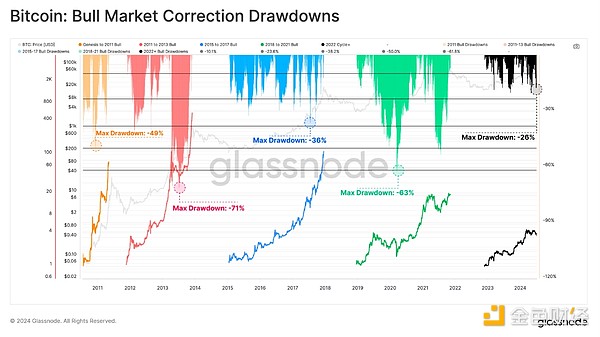
If we evaluate price performance relative to each cycle low, the market performance in 2023-24 is strikingly similar to the previous two cycles (2018-21 and 2015-17). The reason why Bitcoin has followed such a similar path is a topic of frequent debate, but it continues to provide a valuable framework for analysts to think about cycle structure and duration.
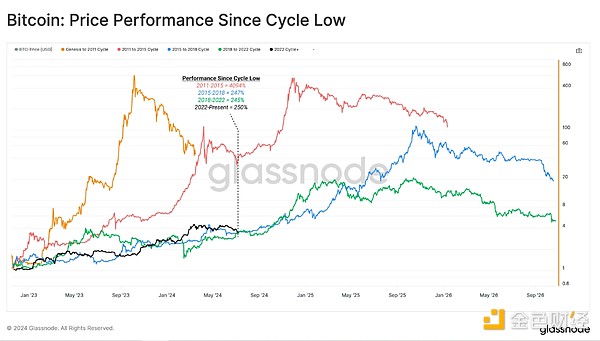
However, if we benchmark performance against the Bitcoin halving date, the current cycle is one of the worst performing, despite the market breaking out to new cyclical highs ahead of the April halving event, the first time this has happened.
Epoch 2: +117% (red)
Epoch 3: -7% (Blue)
Epoch 4: + 30% (green)
Epoch 5: -13% (grey)
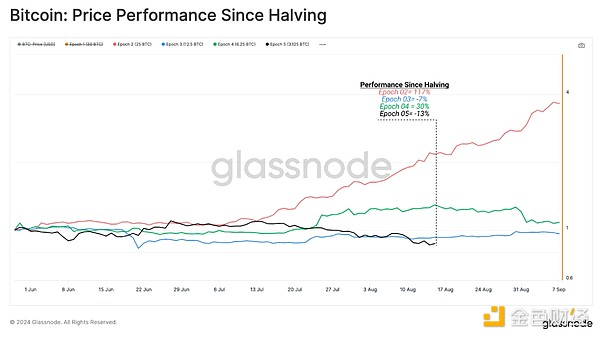
We can evaluate on a daily basis the number of times a daily decline in an uptrend exceeded the 1 standard deviation threshold. This helps us assess the number of significant selling events that investors experienced throughout the bull market uptrend.
2011-13: 19 events;
2015-18: 27 incidents;
2018-21: 26 events;
Current cycle 2023-24: 6 events (to date).
The current cycle has recorded 6 daily declines of more than 1 standard deviation below the long-term average. This suggests that the current cycle is either significantly shorter and less volatile than previous ones, or that investors have more fuel.
New investors in trouble
Assessing the supply held by short-term holders, we can see a substantial increase starting in January 2024. This is accompanied by an explosive rise in price after the spot ETF goes live and reflects a strong inflow of new demand.
However, this demand profile has reached a plateau of growth in recent months, suggesting a balance between supply and demand in the second quarter of 2024. Since then, the oversupply situation has given way to an oversupply situation as fewer long-term holders have taken profits and fewer new buyers have entered the market to accumulate holdings.
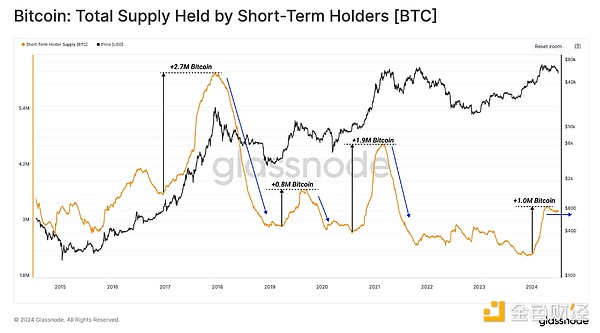
In a sustained bull market, a local bottom is usually formed when the loss supply held by short-term holders reaches about 1 million to 2 million BTC. In more severe cases, the loss supply may peak between 2 million and 3 million BTC.
We can see an example of this in the recent sell-off, when the price dropped to around $53,000, leaving holders of over 2.8 million BTC below their cost of holding. This is the second time this has happened in the past 12 months, with August 2023 being another example where new investors were left holding over 2 million BTC at unrealized losses.
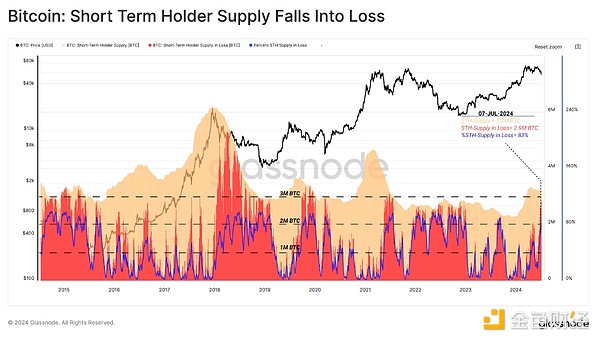
We can assess the intensity of these periods by counting the number of days that more than 2 million short-term holder tokens were underwater for at least 90 days. By this metric, there have been 20 active days so far.
If we compare to market conditions in Q2-Q3 2021, short-term holders experienced a longer period of severe financial stress, 70 consecutive days. That period was long enough to break investor sentiment, second only to the destructive 2022 bear market. In comparison, this cycle is currently relatively still in the making.
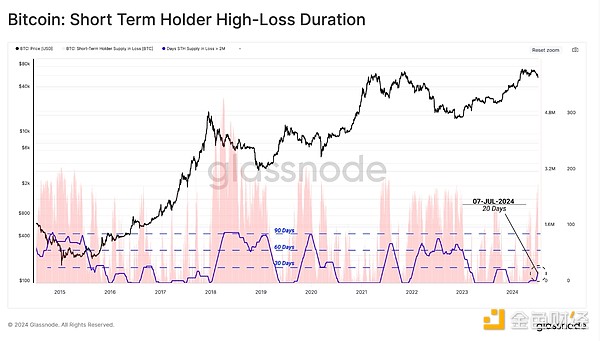
Profitability Stagnation
As spot prices continue to fall, the ratio between investors actual profits and actual losses has also fallen. The indicator has now fallen to the range of 0.50 to 0.75, which is a more neutral level during a bull market correction.
We can also see that the indicator exhibits a similar pattern of wild swings throughout the 2019-2022 cycle, which can be seen as a reflection of inherent instability and investor uncertainty.
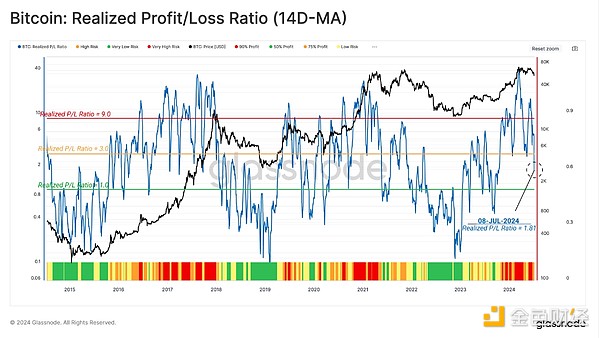
Looking specifically at the losses of short-term holders, we can see that this group locked in about $595 million in actual losses this week. This is the largest loss event since the 2022 cycle low.
Furthermore, only 52 trading days out of 5,655 (< 1%) recorded larger daily losses, highlighting the severity of this correction in USD terms.
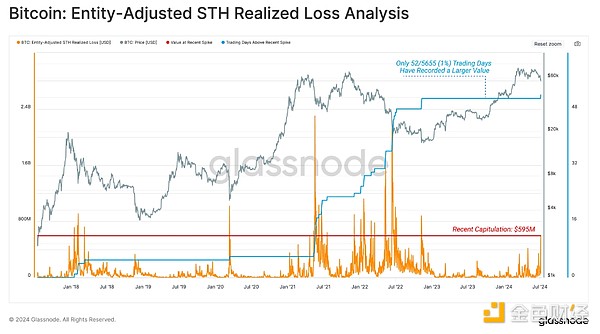
However, when we look at the losses of these short-term holders as a percentage of total invested wealth (divided by STH realized market cap), we see a very different picture. Relatively speaking, the losses locked up by this group are still fairly typical compared to previous bull market corrections.
In the chart below, we’ve highlighted (blue) time periods where both the percentage of losses in short supply holdings and the magnitude of losses locked up deviated from the mean by more than 1 standard deviation.
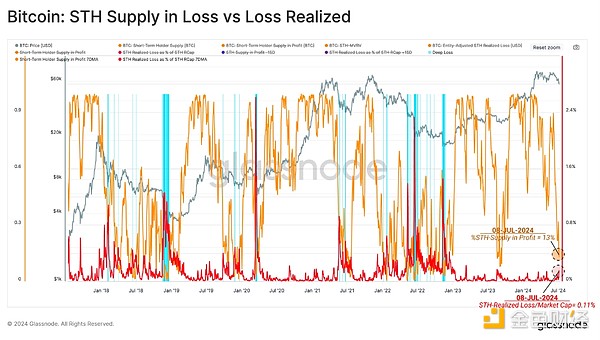
Looking at the losses locked by long-term and short-term holders, we note that this week’s loss events account for less than 36% of total capital flows on the Bitcoin network.
Major sell-off events, such as those in September 2019, March 2020, and May 2021, saw losses account for more than 60% of capital flows over a period of several weeks, with significant contributions from both groups.
Therefore, it can be argued that the current market contraction bears more similarities to the top formation in the first quarter of 2021 than a severe sell-off event. Nonetheless, the onus remains on the demand side to curb negative price momentum, otherwise profitability for investors will continue to deteriorate.
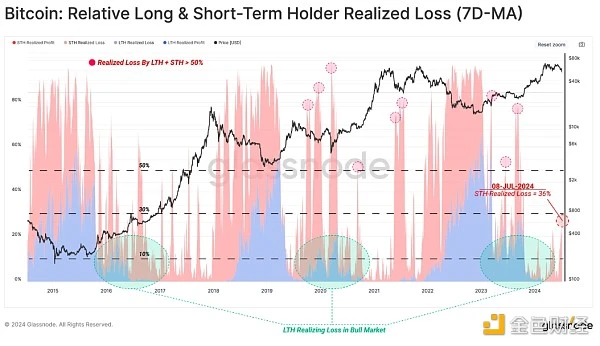
Summarize
After the FTX crash, the market experienced the deepest correction in this cycle after an 18-month rally and 3 months of sideways trading. Nevertheless, the decline in the current cycle still compares favorably with historical cycles, indicating that the market fundamentals are relatively sound.
The sharp contraction put a large number of short-term holders in a position of significant unrealized losses, putting a lot of pressure on this group. However, the size of the locked-in losses is still relatively small compared to the market size. In addition to this, long-term holders rarely participated in the losses, indicating that mature investors remained profitable despite the subsequent market panic.










